Productivity and Community Composition of Low Biomass/High Silica Precipitation Hot Springs: A Possible Window to Earth's Early Biosphere?
- PMID: 31362401
- PMCID: PMC6789502
- DOI: 10.3390/life9030064
Productivity and Community Composition of Low Biomass/High Silica Precipitation Hot Springs: A Possible Window to Earth's Early Biosphere?
Abstract
Terrestrial hot springs have provided a niche space for microbial communities throughout much of Earth's history, and evidence for hydrothermal deposits on the Martian surface suggest this could have also been the case for the red planet. Prior to the evolution of photosynthesis, life in hot springs on early Earth would have been supported though chemoautotrophy. Today, hot spring geochemical and physical parameters can preclude the occurrence of oxygenic phototrophs, providing an opportunity to characterize the geochemical and microbial components. In the absence of the photo-oxidation of water, chemoautotrophy in these hot springs (and throughout Earth's history) relies on the delivery of exogenous electron acceptors and donors such as H2, H2S, and Fe2+. Thus, systems fueled by chemoautotrophy are likely energy substrate-limited and support low biomass communities compared to those where oxygenic phototrophs are prevalent. Low biomass silica-precipitating systems have implications for preservation, especially over geologic time. Here, we examine and compare the productivity and composition of low biomass chemoautotrophic versus photoautotrophic communities in silica-saturated hot springs. Our results indicate low biomass chemoautotrophic microbial communities in Yellowstone National Park are supported primarily by sulfur redox reactions and, while similar in total biomass, show higher diversity in anoxygenic phototrophic communities compared to chemoautotrophs. Our data suggest productivity in Archean terrestrial hot springs may be directly linked to redox substrate availability, and there may be high potential for geochemical and physical biosignature preservation from these communities.
Keywords: carbon uptake; early Earth; hot springs; low biomass; silica precipitating.
Conflict of interest statement
The authors declare no conflicts of interest.
Figures
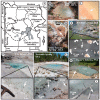

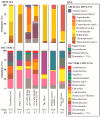
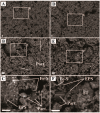


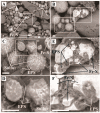
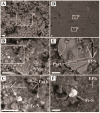
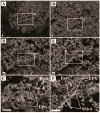

Similar articles
-
Temperature and Geographic Location Impact the Distribution and Diversity of Photoautotrophic Gene Variants in Alkaline Yellowstone Hot Springs.Microbiol Spectr. 2022 Jun 29;10(3):e0146521. doi: 10.1128/spectrum.01465-21. Epub 2022 May 16. Microbiol Spectr. 2022. PMID: 35575591 Free PMC article.
-
Hot Spring Microbial Community Elemental Composition: Hot Spring and Soil Inputs, and the Transition from Biocumulus to Siliceous Sinter.Astrobiology. 2021 Dec;21(12):1526-1546. doi: 10.1089/ast.2019.2086. Astrobiology. 2021. PMID: 34889663
-
Temperature impacts community structure and function of phototrophic Chloroflexi and Cyanobacteria in two alkaline hot springs in Yellowstone National Park.Environ Microbiol Rep. 2020 Oct;12(5):503-513. doi: 10.1111/1758-2229.12863. Epub 2020 Jul 26. Environ Microbiol Rep. 2020. PMID: 32613733 Free PMC article.
-
The trouble with oxygen: The ecophysiology of extant phototrophs and implications for the evolution of oxygenic photosynthesis.Free Radic Biol Med. 2019 Aug 20;140:233-249. doi: 10.1016/j.freeradbiomed.2019.05.003. Epub 2019 May 9. Free Radic Biol Med. 2019. PMID: 31078729 Review.
-
The role of biology in planetary evolution: cyanobacterial primary production in low-oxygen Proterozoic oceans.Environ Microbiol. 2016 Feb;18(2):325-40. doi: 10.1111/1462-2920.13118. Epub 2015 Dec 21. Environ Microbiol. 2016. PMID: 26549614 Free PMC article. Review.
Cited by
-
Comparative Analysis of Microbial Diversity Across Temperature Gradients in Hot Springs From Yellowstone and Iceland.Front Microbiol. 2020 Jul 14;11:1625. doi: 10.3389/fmicb.2020.01625. eCollection 2020. Front Microbiol. 2020. PMID: 32760379 Free PMC article.
-
Metagenome-Assembled Genomes of Novel Taxa from an Acid Mine Drainage Environment.Appl Environ Microbiol. 2021 Aug 11;87(17):e0077221. doi: 10.1128/AEM.00772-21. Epub 2021 Aug 11. Appl Environ Microbiol. 2021. PMID: 34161177 Free PMC article.
-
Anoxygenic Phototrophs Span Geochemical Gradients and Diverse Morphologies in Terrestrial Geothermal Springs.mSystems. 2019 Nov 5;4(6):e00498-19. doi: 10.1128/mSystems.00498-19. mSystems. 2019. PMID: 31690593 Free PMC article.
-
Metabolic adaptations underpin high productivity rates in relict subsurface water.Sci Rep. 2024 Aug 5;14(1):18126. doi: 10.1038/s41598-024-68868-9. Sci Rep. 2024. PMID: 39103408 Free PMC article.
-
Metabolic diversity and co-occurrence of multiple Ferrovum species at an acid mine drainage site.BMC Microbiol. 2020 May 18;20(1):119. doi: 10.1186/s12866-020-01768-w. BMC Microbiol. 2020. PMID: 32423375 Free PMC article.
References
-
- Djokic T., Van Krandendonk M.J., Campbell K.A., Havig J.R., Walter M.R., Guido D.M. A reconstructed subaerial hot spring field in the 3.5 billion-year-old Dresser Formation, North Pole Dome, Pilbara Craton, Western Australia. Astrobiology. 2019 in review. - PubMed
-
- Arvidson R.E., Bell J.F., III, Bellutta P., Cabrol N.A., Catalano J.G., Cohen J., Crumpler L.S., Des Marais D.J., Estlin T.A., Farrand W.H., et al. Spirit Mars Rover Mission: Overview and selected results from the northern Home Plate Winter Haven to the side of Scamander crater. J. Geophys. Res. Planet. 2010;115:E7. doi: 10.1029/2010JE003633. - DOI
-
- Rice M.S., Bell J.F., III, Cloutis E.A., Wang A., Ruff S.W., Craig M.A., Bailey D.T., Johnson J.R., de Souza P.A., Jr., Farrand W.H. Silica-rich deposits and hydrated minerals at Gusev Crater, Mars: Vis-NIR spectral characterization and regional mapping. Icarus. 2010;205:375–395. doi: 10.1016/j.icarus.2009.03.035. - DOI
LinkOut - more resources
Full Text Sources

